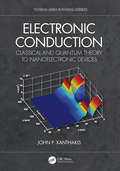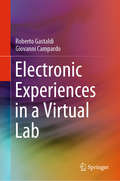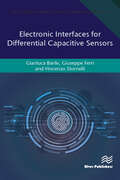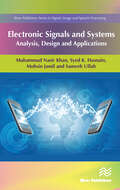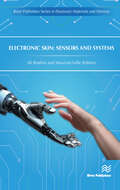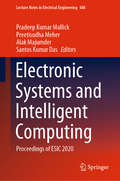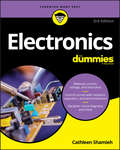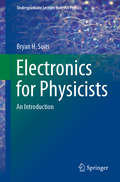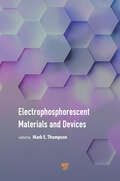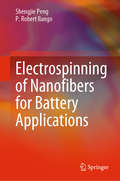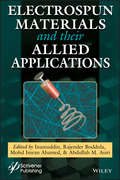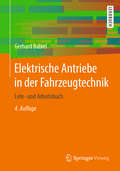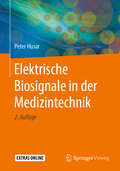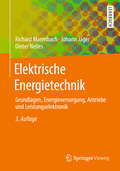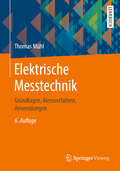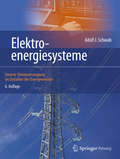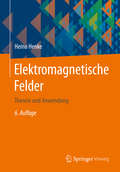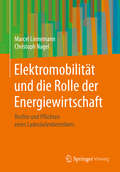- Table View
- List View
Electronic Conduction: Classical and Quantum Theory to Nanoelectronic Devices (Textbook Series in Physical Sciences)
by John P. XanthakisElectronic Conduction: Classical and Quantum Theory to Nanoelectronic Devices provides a concise, complete introduction to the fundamental principles of electronic conduction in microelectronic and nanoelectronic devices, with an emphasis on integrating the quantum aspects of conduction. The chapter coverage begins by presenting the classical theory of conduction, including introductory chapters on quantum mechanics and the solid state, then moving to a complete presentation of essential theory for understanding modern electronic devices. The author’s unique approach is applicable to microscale and nanoscale device simulation, which is particularly timely given the explosion in the nanoelectronics field. Features Self-contained Gives a complete account of classical and quantum aspects of conduction in nanometer scale devices Emphasises core principles, the book can be useful to electrical engineers and material scientists, and no prior course in semiconductors is necessary Highlights the bridge to modern electronics, first presenting the physics, and then the engineering complications related to quantum behaviour Includes many clear, illustrative diagrams and chapter problem sets Gives an account of post-Silicon devices such as the GaAs MOSFET, the CNT-FET and the vacuum transistor Showcases why quantum mechanics is necessary with modern devices due to their size and corresponding electron transport properties Discusses all the issues that will enable readers to conduct their own research
Electronic Conduction: Classical and Quantum Theory to Nanoelectronic Devices (Textbook Series in Physical Sciences)
by John P. XanthakisElectronic Conduction: Classical and Quantum Theory to Nanoelectronic Devices provides a concise, complete introduction to the fundamental principles of electronic conduction in microelectronic and nanoelectronic devices, with an emphasis on integrating the quantum aspects of conduction. The chapter coverage begins by presenting the classical theory of conduction, including introductory chapters on quantum mechanics and the solid state, then moving to a complete presentation of essential theory for understanding modern electronic devices. The author’s unique approach is applicable to microscale and nanoscale device simulation, which is particularly timely given the explosion in the nanoelectronics field. Features Self-contained Gives a complete account of classical and quantum aspects of conduction in nanometer scale devices Emphasises core principles, the book can be useful to electrical engineers and material scientists, and no prior course in semiconductors is necessary Highlights the bridge to modern electronics, first presenting the physics, and then the engineering complications related to quantum behaviour Includes many clear, illustrative diagrams and chapter problem sets Gives an account of post-Silicon devices such as the GaAs MOSFET, the CNT-FET and the vacuum transistor Showcases why quantum mechanics is necessary with modern devices due to their size and corresponding electron transport properties Discusses all the issues that will enable readers to conduct their own research
Electronic Experiences in a Virtual Lab
by Roberto Gastaldi Giovanni CampardoThis book presents a collection of “lessons” on various topics commonly encountered in electronic circuit design, including some basic circuits and some complex electronic circuits, which it uses as vehicles to explain the basic circuits they are composed of. The circuits considered include a linear amplifier, oscillators, counters, a digital clock, power supplies, a heartbeat detector, a sound equalizer, an audio power amplifier and a radio. The theoretical analysis has been deliberately kept to a minimum, in order to dedicate more time to a “learning by doing” approach, which, after a brief review of the theory, readers are encouraged to use directly with a simulator tool to examine the operation of circuits in a “virtual laboratory.” Though the book is not a theory textbook, readers should be familiar with the basic principles of electronic design, and with spice-like simulation tools. To help with the latter aspect, one chapter is dedicated to the basic functions and commands of the OrCad P-spice simulator used for the experiments described in the book.
Electronic Interfaces for Differential Capacitive Sensors
by Gianluca Barile Giuseppe Ferri Vincenzo StornelliIn a world where great efforts are spent designing and creating more complex, yet efficient systems, sensing elements and related readout circuits, which constitute an integral part of them, need to be designed fulfilling these constraints, beside the common key parameters, such as high sensitivity, resolution and accuracy. Capacitive sensors and their differential subset provide virtually no energy dissipation, show insensitivity to temperature variations and have the capability to be micromachined directly onto a silicon substrate, together with the readout interface. Designing a readout circuit that takes advantage of these benefits, according to any specific application, is thus of utmost importance. This volume introduces the reader to state-of-the-art techniques and research achievements in interfacing differential capacitance sensors.Technical topics discussed in the book include:▪ Switched capacitor based interfaces;▪ Voltage mode, differential capacitance to time, voltage, digital converters;▪ Current mode interfaces based on standard components;▪ Current mode interfaces based on CCIIs and VCIIs;▪ Principles of second generation current and voltage conveyors.This book gives the reader a comprehensive overview on the working principles, equivalent circuit models and most advanced interfacing techniques for differential capacitive transducers, highlighting benefits and downsides of each option. Electronic interfaces for differential capacitive sensors is an ideal text for academic staff and Masters/research students in electronic and microelectronic engineering.
Electronic Interfaces for Differential Capacitive Sensors
by Gianluca Barile Giuseppe Ferri Vincenzo StornelliIn a world where great efforts are spent designing and creating more complex, yet efficient systems, sensing elements and related readout circuits, which constitute an integral part of them, need to be designed fulfilling these constraints, beside the common key parameters, such as high sensitivity, resolution and accuracy. Capacitive sensors and their differential subset provide virtually no energy dissipation, show insensitivity to temperature variations and have the capability to be micromachined directly onto a silicon substrate, together with the readout interface. Designing a readout circuit that takes advantage of these benefits, according to any specific application, is thus of utmost importance. This volume introduces the reader to state-of-the-art techniques and research achievements in interfacing differential capacitance sensors.Technical topics discussed in the book include:▪ Switched capacitor based interfaces;▪ Voltage mode, differential capacitance to time, voltage, digital converters;▪ Current mode interfaces based on standard components;▪ Current mode interfaces based on CCIIs and VCIIs;▪ Principles of second generation current and voltage conveyors.This book gives the reader a comprehensive overview on the working principles, equivalent circuit models and most advanced interfacing techniques for differential capacitive transducers, highlighting benefits and downsides of each option. Electronic interfaces for differential capacitive sensors is an ideal text for academic staff and Masters/research students in electronic and microelectronic engineering.
Electronic Signals and Systems: Analysis, Design and Applications
by Muhammad Nasir Khan Syed K. Hasnain Mohsin Jamil Ali ImranThe subject of Signals and Systems is enormously complex, involving many concepts such as signals, mathematics and filter design that are woven together in an intricate manner. To cope with this scope and complexity, many Signals and Systems texts are often organized around the “numerical examples” of a system. With such organization, students can see through the complexity of Signals and Systems, they can learn about the distinct concepts and protocols in one part of the communication system while seeing the big picture of how all parts fit together. From a pedagogical perspective, our personal experience has been that such approach indeed works well.Based on the Authors extensive experience of teaching and research, the book is written with such a reader in mind. The Book is intended for a course on signals & systems at the senior undergraduate level and above. The authors consider all the requirements and tools used in analysis and design of discrete time systems for filter design and signal processing.Key features of the International Edition:• The extensive use of MATLAB based examples to illustrate how to solve the signals & systems problems. The textbook includes a wealth of problems with solutions.• Worked-out examples have been included to explain new and difficult concepts and to expose the reader to real-life signal processing problems.The inclusion of FIR and IIR filter design further enriches the contents of the book.
Electronic Signals and Systems: Analysis, Design and Applications
by Muhammad Nasir Khan Syed K. Hasnain Mohsin Jamil Ali ImranThe subject of Signals and Systems is enormously complex, involving many concepts such as signals, mathematics and filter design that are woven together in an intricate manner. To cope with this scope and complexity, many Signals and Systems texts are often organized around the “numerical examples” of a system. With such organization, students can see through the complexity of Signals and Systems, they can learn about the distinct concepts and protocols in one part of the communication system while seeing the big picture of how all parts fit together. From a pedagogical perspective, our personal experience has been that such approach indeed works well.Based on the Authors extensive experience of teaching and research, the book is written with such a reader in mind. The Book is intended for a course on signals & systems at the senior undergraduate level and above. The authors consider all the requirements and tools used in analysis and design of discrete time systems for filter design and signal processing.Key features of the International Edition:• The extensive use of MATLAB based examples to illustrate how to solve the signals & systems problems. The textbook includes a wealth of problems with solutions.• Worked-out examples have been included to explain new and difficult concepts and to expose the reader to real-life signal processing problems.The inclusion of FIR and IIR filter design further enriches the contents of the book.
Electronic Skin: Sensors and Systems
Considerable amount of effort has been devoted, over the recent years, towards the development of electronic skin (e-skin) for many application domains such as prosthetics, robotics, and industrial automation. Electronic Skin: Sensors and Systems focuses on the main components constituting the e-skin system. The e-skin system is based on: i) sensing materials composing the tactile sensor array, ii) the front end electronics for data acquisition and signal conditioning, iii) the embedded processing unit performing tactile data decoding, and iv) the communication interface in charge of transmitting the sensors data for further computing. Technical topics discussed in the book include: • Tactile sensing material; • Electronic Skin systems;• Embedded computing and tactile data decoding; • Communication systems for tactile data transmission; • Relevant applications of e-skin system; The book takes into account not only sensing materials but it also provides a thorough assessment of the current state of the art at system level. The book addresses embedded electronics and tactile data processing and decoding, techniques for low power embedded computing, and the communication interface. Electronic Skin: Sensors and Systems is ideal for researchers, Ph.D. students, academic staff and Masters/research students in sensors/sensing systems, embedded systems, data processing and decoding, and communication systems.
Electronic Skin: Sensors and Systems
by Ali Ibrahim Maurizio ValleConsiderable amount of effort has been devoted, over the recent years, towards the development of electronic skin (e-skin) for many application domains such as prosthetics, robotics, and industrial automation. Electronic Skin: Sensors and Systems focuses on the main components constituting the e-skin system. The e-skin system is based on: i) sensing materials composing the tactile sensor array, ii) the front end electronics for data acquisition and signal conditioning, iii) the embedded processing unit performing tactile data decoding, and iv) the communication interface in charge of transmitting the sensors data for further computing. Technical topics discussed in the book include: • Tactile sensing material; • Electronic Skin systems;• Embedded computing and tactile data decoding; • Communication systems for tactile data transmission; • Relevant applications of e-skin system; The book takes into account not only sensing materials but it also provides a thorough assessment of the current state of the art at system level. The book addresses embedded electronics and tactile data processing and decoding, techniques for low power embedded computing, and the communication interface. Electronic Skin: Sensors and Systems is ideal for researchers, Ph.D. students, academic staff and Masters/research students in sensors/sensing systems, embedded systems, data processing and decoding, and communication systems.
Electronic Systems and Intelligent Computing: Proceedings of ESIC 2020 (Lecture Notes in Electrical Engineering #686)
by Pradeep Kumar Mallick Preetisudha Meher Alak Majumder Santos Kumar DasThis book presents selected, high-quality research papers from the International Conference on Electronic Systems and Intelligent Computing (ESIC 2020), held at NIT Yupia, Arunachal Pradesh, India, on 2 – 4 March 2020. Discussing the latest challenges and solutions in the field of smart computing, cyber-physical systems and intelligent technologies, it includes papers based on original theoretical, practical and experimental simulations, developments, applications, measurements, and testing. The applications and solutions featured provide valuable reference material for future product development.
Electronics For Dummies (For Kids For Dummies Ser.)
by Cathleen ShamiehBuild your electronics workbench—and begin creating fun electronics projects right away Packed with hundreds of colorful diagrams and photographs, this book provides step-by-step instructions for experiments that show you how electronic components work, advice on choosing and using essential tools, and exciting projects you can build in 30 minutes or less. You'll get charged up as you transform theory into action in chapter after chapter! Circuit basics — learn what voltage is, where current flows (and doesn't flow), and how power is used in a circuit Critical components — discover how resistors, capacitors, inductors, diodes, and transistors control and shape electric current Versatile chips — find out how to use analog and digital integrated circuits to build complex projects with just a few parts Analyze circuits — understand the rules that govern current and voltage and learn how to apply them Safety tips — get a thorough grounding in how to protect yourself—and your electronics—from harm Electronics For Dummies (9781119675594) was previously published as Electronics For Dummies (9781119117971). While this version features a new Dummies cover and design, the content is the same as the prior release and should not be considered a new or updated product.
Electronics For Dummies
by Cathleen ShamiehBuild your electronics workbench—and begin creating fun electronics projects right away Packed with hundreds of colorful diagrams and photographs, this book provides step-by-step instructions for experiments that show you how electronic components work, advice on choosing and using essential tools, and exciting projects you can build in 30 minutes or less. You'll get charged up as you transform theory into action in chapter after chapter! Circuit basics — learn what voltage is, where current flows (and doesn't flow), and how power is used in a circuit Critical components — discover how resistors, capacitors, inductors, diodes, and transistors control and shape electric current Versatile chips — find out how to use analog and digital integrated circuits to build complex projects with just a few parts Analyze circuits — understand the rules that govern current and voltage and learn how to apply them Safety tips — get a thorough grounding in how to protect yourself—and your electronics—from harm Electronics For Dummies (9781119675594) was previously published as Electronics For Dummies (9781119117971). While this version features a new Dummies cover and design, the content is the same as the prior release and should not be considered a new or updated product.
Electronics for Physicists: An Introduction (Undergraduate Lecture Notes in Physics)
by Bryan H. SuitsThis book provides undergraduate physics majors and students of related sciences with a sound basic understanding of electronics and how it is used, principally in the physical sciences. While today few science students go on to careers that demand an ability to design and build electronic circuits, many will use and rely on electronics. As scientists, they will require an appropriate level of fundamental knowledge that enables them, for example, to understand what electronic equipment is doing, to correctly interpret the measurements obtained, and to appreciate the numerous links between electronics and how it is practiced, and other areas of science. Discussing electronics in the broader context and from the point of view of the scientist, this book is intended for students who are not planning to become electronics specialists. It has been written in a relatively informal, personal style and includes detailed examples, as well as some “outside the box” material to inspire thought and creativity. A selection of relevant exercises is included at the end of each chapter.
Electrophosphorescent Materials and Devices
by Mark E. ThompsonOrganic LEDs (OLEDs) in mobile displays have been in large-scale production for over a decade, and OLED-based televisions are rapidly gaining traction in the marketplace. OLEDs are on the verge of entering the solid-state lighting market in a big way. The OLED technology gives higher color purity and is more efficient than any of the competing technologies. When produced at scale, OLEDs are also economical. A key limitation in the development of OLEDs was the efficient conversion of all of the electrical energy put into the device into light. Until the late 1990s, the maximum efficiency of OLEDs was limited to 25% (photons/electrons), but this limitation was removed and OLEDs with 100% efficiency were reported in the early 2000s. This advance in OLED technology was driven by the author of this book. He and his collaborators developed electrophosphorescence, which is essential in reaching the 100% efficiency that is now commonplace in commercial devices.
Electrophosphorescent Materials and Devices
by Mark ThompsonOrganic LEDs (OLEDs) in mobile displays have been in large-scale production for over a decade, and OLED-based televisions are rapidly gaining traction in the marketplace. OLEDs are on the verge of entering the solid-state lighting market in a big way. The OLED technology gives higher color purity and is more efficient than any of the competing technologies. When produced at scale, OLEDs are also economical. A key limitation in the development of OLEDs was the efficient conversion of all of the electrical energy put into the device into light. Until the late 1990s, the maximum efficiency of OLEDs was limited to 25% (photons/electrons), but this limitation was removed and OLEDs with 100% efficiency were reported in the early 2000s. This advance in OLED technology was driven by the author of this book. He and his collaborators developed electrophosphorescence, which is essential in reaching the 100% efficiency that is now commonplace in commercial devices.
Electrospinning of Nanofibers for Battery Applications
by Shengjie Peng P. Robert IlangoThis book comprehensively discusses the basic principles and working mechanism of all kind of batteries towards clean energy storage devices. In addition, it focuses on the synthesis of various electrode materials with 1D architecture via electrospinning technique. This book will give a clear idea about recent synthetic strategy towards nanofibers and nanocomposites for alkali-ion storage applications. The reader could understand the formation mechanism of nanofibers and their potential application in the future energy storage system.
Electrospun Materials and Their Allied Applications
by Inamuddin Rajender Boddula Mohd Imran Ahamed Abdullah M. AsiriThe aim of this book is to explore the history, fundamentals, manufacturing processes, optimization parameters, and applications of electrospun materials. The book includes various types of electrospun materials such as antimicrobial, smart, bioinspired systems. It focuses on the many application areas for electrospun materials such as energy storage and harvesting, catalysis, biomedical including gene delivery and tissue engineering, separation, adsorption and water treatment technologies, packaging. The book emphasizes the enhanced sustainable properties of electrospun materials, with the challenges and future developments being discussed in detail. The chapters are written by top-class researchers and experts from throughout the world.
Electrospun Materials and Their Allied Applications
by Rajender Boddula Inamuddin Mohd Imran Ahamed Abdullah M. AsiriThe aim of this book is to explore the history, fundamentals, manufacturing processes, optimization parameters, and applications of electrospun materials. The book includes various types of electrospun materials such as antimicrobial, smart, bioinspired systems. It focuses on the many application areas for electrospun materials such as energy storage and harvesting, catalysis, biomedical including gene delivery and tissue engineering, separation, adsorption and water treatment technologies, packaging. The book emphasizes the enhanced sustainable properties of electrospun materials, with the challenges and future developments being discussed in detail. The chapters are written by top-class researchers and experts from throughout the world.
Elektrische Antriebe in der Fahrzeugtechnik: Lehr- und Arbeitsbuch (Studium Technik Ser.)
by Gerhard BabielDas Lehrbuch vermittelt die Grundlagen von der Energiegewinnung über die Energiewandlung bis zur Drehfeldmaschine und deren Anwendung in heutigen und vor allem zukünftigen Antriebssystemen. Zunächst werden aktuelle und zukünftige Energiequellen für Fahrzeugantriebe vorgestellt und miteinander verglichen. Darauf aufbauend werden elektrochemische Energiespeicher und -wandler wie die Brennstoffzelle behandelt. Diese kommen u. a. in E- oder Hybridfahrzeugen zum Einsatz. Es werden nicht nur die Standardmaschinen wie Gleichstrom-, Asynchron-, Synchron- und Linearmotor erklärt, sondern auch solche, die in zukünftigen Pkw- und Bahnantrieben zum Einsatz kommen werden, wie z. B. Reluktanz-, Transversalfluss- und Digital-Motoren. Im letzten Kapitel werden Antriebssysteme am Beispiel einer E-Lok und der Magnetschwebebahn bzw. dem supraleitenden MAGLEV vorgestellt. Ein eigenes Kapitel ist dem Kinetic Energy Restoring System KERS gewidmet, welches in der Formel 1 bereits erfolgreich zum Einsatz kommt. Schrittmotoren ergänzen das Kapitel E-Maschinen.
Elektrische Biosignale in der Medizintechnik
by Peter HusarDas grundlegende Kompendium führt in das zunehmend wichtiger werdende Thema der Biosginalverarbeitung ein. Der inhaltliche Aufbau orientiert sich an der Abfolge der diagnostischen Kette: von Sensorik, Signalverstärkung und -konditionierung über Signalabtastung und -digitalisierung, Methoden der Biosignalverarbeitung bis zu Auswertung und Diagnosevorschlag. Dabei liefert jedes Kapitel das entsprechende theoretische und methodische Wissen, behandelt Realisierungsalternativen und stellt Praxisbeispiele sowie die aktuell verfügbare Technik vor.
Elektrische Energietechnik: Grundlagen, Energieversorgung, Antriebe und Leistungselektronik (Leitfaden Der Elektrotechnik Ser.)
by Richard Marenbach Johann Jäger Dieter NellesDie elektrische Energietechnik ist ein Teilgebiet der Elektrotechnik. Dieses Buch behandelt das gesamte Lehrgebiet aus einem Guss und eignet sich so als Begleiter durch das Studium und zum späteren Nachschlagen. Die hohe gesellschaftliche Relevanz der Energietechnik führt in der Öffentlichkeit zu emotional geladenen Diskussionen. Es seien nur einige Schlagworte genannt: thermische Kraftwerke, regenerative Energien, Energiewende, Elektromobilität. Das Buch erläutert die relevanten Zusammenhänge zu diesen Gebieten in allgemein verständlicher Form und ohne ideologische Festlegungen.
Elektrische Messtechnik: Grundlagen, Messverfahren, Anwendungen
by Thomas MühlDieses Lehrbuch vermittelt die Grundlagen und Verfahrensweisen der elektrischen Messtechnik zusammen mit ihrer praxisorientierten Anwendung. Nach einer Einführung in messtechnische Begriffe und grundlegende Beschreibungen elektrischer Messgeräte werden die Messprinzipien sowie die analogen und digitalen Verfahren zur Messung der wichtigsten elektrischen Größen erläutert. Schwerpunkte sind die Möglichkeiten und Einsatzbereiche aktueller Messsysteme sowie deren spezifische Besonderheiten. Das Buch deckt die wesentlichen Inhalte einer Vorlesung über die elektrische Messtechnik ab, wie sie Studierende der Elektrotechnik hören. Die fünfte Auflage ist aktualisiert und in einigen Kapiteln wie der Leistungsmessung erweitert.
Elektroenergiesysteme: Smarte Stromversorgung im Zeitalter der Energiewende
by Adolf J. SchwabIn außergewöhnlich verständlicher Weise führt dieses Buch in die Komplexität moderner Elektroenergiesysteme und insbesondere in das Generationenprojekt Energiewende ein. Von der Umwandlung der Primärenergieressourcen der Erde in konventionellen thermischen Kraftwerken bis hin zur aktuellen Migration des überwiegenden Teils der deutschen Jahresstromproduktion weg von den großen Kraftwerken zu Millionen dezentraler EE-Stromerzeugungsanlagen in den Verteilnetzen behandelt das Buch das gesamte Spektrum der Erzeugung, Übertragung und Verteilung elektrischer Energie. Der Paradigmenwechsel in der Stromproduktion und Stromverteilung geht einher mit der Aufrüstung klassischer Verteilnetze zu Smart Grids mittels kommunikationsfähiger, intelligenter Messsysteme sowie umfassender Änderungen ihrer Netzführung und Netzbereitstellung. Besondere Beachtung erfahren wirtschaftliche Aspekte im Rahmen der Liberalisierung des Strommarktes und der Energiewende sowie informationstechnische Aspekte sicherer Kraftwerks- und Netzleittechnik. Visionen von Smart Homes und Smart Cities sowie potentiellen Optionen künftiger Energiespeicherung lassen die weitere Evolution der allgemeinen Stromversorgung erahnen. Neu aufgenommen wurden auch die seltenen Risiken flächendeckender Blackouts durch geomagnetische Stürme oder nukleare elektromagnetische Impulse. Schließlich rundet eine neue Sichtweise und Begriffsbildung bezüglich Wirk- und Blindleistungen die 6. Auflage ab. Das Buch wendet sich vorrangig an Studierende und Berufsanfänger der Elektrotechnik sowie an alle in der Praxis stehenden Ingenieure und Fachleute anderer Disziplinen, die mit Elektroenergiesystemen, der Energiewende und allen daraus resultierenden Veränderungsprozessen in der allgemeinen und industriellen Stromversorgung befasst sind.
Elektromagnetische Felder: Theorie und Anwendung
by Heino HenkeDas Buch behandelt die Grundgesetze des elektromagnetischen Feldes, inklusive relativistischer Vorgänge, und zeigt exemplarisch ihre Bedeutung für die verschiedensten ingenieurwissenschaftlichen und physikalischen Fachrichtungen. Anhand eingestreuter Beispiele und Animationen im Internet lernt der Leser wie man durch sinnvolle Vereinfachungen zur Modellbildung und zur Lösung gelangt. Da die numerische Simulation ein wichtiges Handwerkszeug darstellt, bietet das Buch mehrere einführende Kapitel zur numerischen Behandlung von Feldproblemen. Neu sind in der 5. Auflage, neben der Überarbeitung verschiedener Kapitel, die Behandlung von dispersiven und anisotropen Medien sowie Streuung und Beugung von Wellen.
Elektromobilität und die Rolle der Energiewirtschaft: Rechte und Pflichten eines Ladesäulenbetreibers
by Marcel Linnemann Christoph NagelElektromobilität ist spätestens seit dem Pariser Klimaschutzabkommen und Fridays for Future im Fokus der Öffentlichkeit. Bis 2030 soll 20 % des Verkehrs elektrisch fahren. Diesbezüglich stehen oft die technischen Herausforderungen der Elektromobilität im Vordergrund. Die grundsätzlichen Fragen der Energiewirtschaft stehen oft im Hintergrund: Welche Aufgabe hat welche Marktrolle (Netz, Vertrieb, MSB…)? Welche Marktrolle nimmt der Ladesäulenbetreiber ein? Wie wird mit Drittstrommengen durch Ladesäulen auf Betriebsgeländen umgegangen? Diese Fragen und vieles mehr, soll das Buch: Die Rolle des Ladesäulenbetreibers, Elektromobilität in der Energiewirtschaft beantworten. Im Gegensatz zu bestehender Literatur soll nicht die Integration in die Stromnetze oder der Aufbau eines E-Autos im Vordergrund stehen, vielmehr sollen die energiewirtschaftlichen Zusammenhänge und Aufgaben der Marktrollen im Vordergrund stehen. Das Buch soll den klaren Fokus haben, Praktiker in ihrem Arbeitsalltag zu unterstützen.
